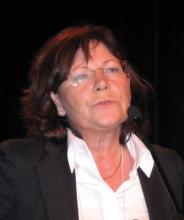BRUSSELS – Use of high-tibial osteotomy as surgical treatment for knee osteoarthritis dwindled during the decade ending in 2007, according to data collected on nearly 2,900 Swedish patients during the 10-year period.
During the same decade, use of total-knee arthroplasty (TKA) for knee osteoarthritis increased, especially in patients younger than 55 years, Annette W-Dahl, Ph.D., said at the annual World Congress on Osteoarthritis.
Despite diminished use, the revision rate following high-tibial osteotomy (HTO) remained modest, with a 29% rate after 10 years. That performance record for HTO suggests that using it first has the potential to delay significantly the need for TKA in patients with severe knee osteoarthritis, making HTO an attractive option for younger patients, said Dr. W-Dahl, a researcher in the department of orthopedics at Lund (Sweden) University.
During 1998-2007, HTO use in Sweden fell from about 5% of primary knee reconstructions for osteoarthritis in 1998 to abut 2% 10 years later. In contrast, use of TKR rose from 78% in 1998 to about 90% in 2007. Use of a third surgical option, unicompartmental knee arthroplasty, also dropped during the decade studied, from 17% in 1998 to 8% in 2007. The low rate of HTO use throughout the decade contrasts with a roughly 30% share of all Swedish primary knee reconstructions about 30 years ago.
Use of HTO also lags today in the United States, with an annual rate probably similar to Sweden’s, commented Dr. Jeffrey N. Katz, professor of medicine at Harvard Medical School in Boston and director of the orthopedics and arthritis center for outcomes research at Brigham and Women’s Hospital in that city. It remains unclear whether use of HTO actually delays the time when a patient with severe osteoarthritis needs TKA, he added.
The new analysis used data collected by the Swedish National Board of Health and Welfare. During the decade reviewed, surgeons performed 3,196 HTOs in 2,893 patients. Two-thirds were men, and their average age was 52 years, with 62% of the patients being younger than 55 years, and 97% aged 65 years or younger. The annual tally of HTOs fell from nearly 400 in 1998 to about 260 in 2007.
Analysis of the surgery done on patients younger than 55 years showed that use of TKA in this age group jumped fivefold, from about 100 in 1998 to more than 500 in 2007. Concurrently, use of HTO dropped, from about 230 in 1998 to about 180 in 2007; use of unicompartmental knee arthroplasty remained relatively stable throughout the decade, with about 100 cases done each year, said Dr. W-Dahl at the congress, which was organized by the Osteoarthritis Research Society International.
The cumulative need for revision surgery in patients who initially underwent HTO surgery ran 29% during the period studied, with women having a statistically significant 30% higher revision rate, compared with men, after adjustment for age and year of surgery.
Among patients younger than 65 years, cumulative revision rates for the three types of surgery during the 10 years studied showed clear differences, with 27% of HTO patients requiring a revision, compared with 16% of patients undergoing unicompartmental knee arthroplasty, and 8% with a TKA.
Dr. W-Dahl had no disclosures.


